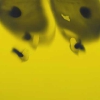Hosaeng Kang: ‘The Margins of Life’
Artist: Hosaeng Kang
‘The Margins of Life’
I have explored ink painting for a long time, but I do not merely remain in doing paintings. The reason is because as a work of studying the limits of materials which will be made into paintings, one must know the unique physiology of materials. It is a duty that needs to study the types of brushes and their characteristics, the merits and demerits of the Indian ink, and the limits of paper and fabric. Ink painting is an area that can only be approached by having sensational technique and intuitive sensitivity in which Indian ink, the amount of water, the speed of brush strokes, strength and flexibility, balance of tones of right and left, top and bottom, time difference between matters, etc follow. Of course, there may be people who sympathize with this area, however, most of the people merely remain at the step of understanding such world. As I go deeper into insight, this world is more an more difficult and lonesome.
Because such ink painting is an area that requires the upmost of senses, there are no words to express the pleasure of experience. My works, up until now, were works that centered on ink painting that expressed the intrinsic pleasures of lines with drawing elements, not restricting the objects of subject matters, but the flow of recent works shows forms of column of water and signs of lines by using Indian ink and colors on top of fabrics.
In the East, there is a saying that five sounds deafen the ears and five colors blind the eyes. It can be said that living in a world of colors, by taking colors for granted without any resistance, our sense of diagnosing the beauty of colors and the danger of colors have rather become numb. My first works which used a minimum of clear colors, as they had been applied as means of supplement for giving fresh ventilation on the monotone of the solemn ink painting, I had expressed the quaint beauty of the monotone by moderating the five colors. However, in the works after, I actively induced light-coloring, which was minimally tried. I in fact wanted to express with primary colors, even. These primary colors are the reality of the physical world that give tension and they are compared to a black hole where things get sucked in at a very fast speed. Therefore, the active attempt of primary colors mean the dynamics of the real generation. It is reflecting the reality of which we cannot escape from the black hole as we have become tamed to all the visuals without any sensation.
What I always pursue, in my inner side, within such reality, is the ‘haven of souls.’ The haven can be called to be the ‘margin of life.’
Here, I work by selecting ‘Indian ink’ in order to connect between the margin of mental concept and the dynamics of colors which mean the black hole reality. This Indian ink of monotone, the middle media of both sides, neutralizes the dynamics of colors with ‘sinking’, ‘spreading’, and ‘calmness.’ Consequently, sacrifice as a neutralizing effect gives birth to life. As it produces a margin of life by offering myself from between the reality of colors and the unreality of margin, the Indian ink can be said to be the street corner of haven. Therefore, this ‘life’ exists only by including ‘color’ and ‘Indian ink’ at the same time. Because this can only be born with the best conclusion that does not commit the foolishness of having to choose between the two, the value of life is that much noble.
To put it in other words, I aim to synthesize the ‘energy of margin’ into new ‘life’ by placing Indian ink in a position where antithesis is made on the thesis of the physical reality. Because this is a concept of convergence that satisfies all three, I will constantly re-explore such work of synthesis.

In my heart and paintings, I always talk about the margin, and the margin provides the only exit that can escape the black hole, enabling us to taste pleasures of mental amusement. Whether it be primary colors or monotone, my work eventually prioritizes the form of space, emptying myself by abandoning it. Nothingness, whiteness and emptiness are identical that are not much different from each other, and as nothingness is the origin of existence, the existing something will be complete at last when it reaches nothing. That is, what is ‘visible’ will yield fruit when it reaches what is ‘invisible.’ Because river water reaches the sea when it abandons the river, and the tree fructifies when it abandons its flower, the part in which I indulge is the margin! The ‘empty space.’ The margin! It is an ‘empty fulfillment.’ It is an empty space fulfilled. It is a light weightiness. It is a breathing space. I love the margin because it can be filled with emptiness.

In conclusion, this work is an amusement of margin through dynamics of color and the calmness of Indian ink. Color, Indian ink, and margin are each called reality, sacrifice, and sensibility. That is, because it is to create emotional value of the new invisible margin conceived from the heterogeneous common denominator of the visible chromatic color and achromatic color, I call this margin in the name of ‘life.’
In addition, we cannot have our beauty of sensitivity extorted, drifted away by the black hole of reality that sucks in at the speed of light, Because the matrix which produces nature is an invisible sensitivity, had one chase only after visible reality, it would clearly be a life with changed position and a work with changed position, which I thus refuse to do so. Therefore, my work respects the contingency and necessity of Indian ink subsumed within providence, and I wish to walk the path of which I wish to go with an upright heart in silence, not deceiving myself.


